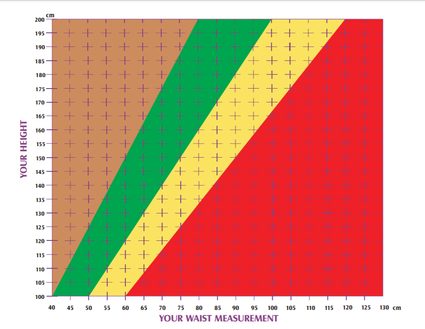Waist to Height Ratio Calculator
Our waist-to-height ratio (WHtR) calculator estimates your waist-height ratio, a simple yet effective indicator of centralized obesity and any associated cardiometabolic risk. Read on to find tips on how to measure your waist. You can also check your body shape using our body shape calculator.
We try our best to make our Omni Calculators as precise and reliable as possible. However, this tool can never replace a professional doctor's assessment. If any health condition bothers you, consult a physician.
Why is waist-height ratio important?
The waist-to-height ratio is a measure of the distribution of body fat. The higher someone's waist-height ratio is, the higher their risk of obesity-related cardiovascular diseases, as it is a rough estimate of obesity. To explore information about body fat further, visit body fat calculator.
Studies have found that a person's waist-height ratio is a good indicator of their risk of heart attack, stroke, or death, while its link to diabetes hasn't been proved yet. Other indicators of abdominal obesity are body mass index (BMI) and waist-hip ratio. See our BMI calculator and this waist-to-hip ratio calculator for more information.
This , which covers all cardiometabolic outcomes from studies in fourteen different countries, sets the following cut-off values for WtHR:
- 0.50 for men; and
- 0.50 for women.
Shape chart based on waist-to-height-ratio
After research showed that WHtR was as good a predictor of health outcomes as waist circumference and waist-to-hip ratio, a simple "Shape Chart" was produced:

Diagram description:
-
Waist circumference is presented along the x-axis, and height on the y-axis.
-
Chart is suitable for adults and children over 5 years old.
-
The cut-off values for waist-to-height ratio are set at WHtR 0.4 (brown to green), 0.5 (green to yellow) and 0.6 (yellow to red).
-
The brown area indicates Take Care – you might be underweight; no need to decrease your waist circumference.
-
The Green area indicates OK.
-
Yellow area indicates Consider Action for adults and Take Action for children.
-
Red area indicates Take Action.
The chart presented above was created by Margaret Ashwell and comes from the following publication:
- .
How to measure your waist?
According to the WHO's data gathering protocol, the waist circumference should be measured at the midpoint between the last palpable rib and the top of the iliac crest, using a stretch‐resistant tape measure.
Practically, the measurements are usually taken at the smallest circumference of the natural waist, usually just above the belly button.
What does waist to height ratio calculator do?
The waist-height ratio is calculated as waist measurement divided by height measurement, W / H, in centimeters. For example, a person with a 28 in (71 cm) waist and 5 ft 7 in (170 cm) height has a waist–height ratio of 0.42.
How do I calculate waist-to-height ratio?
To calculate your waist-to-height ratio:
- Measure your waist circumference midway between the lower rib and the iliac crest (this is usually just above the belly button).
- Determine your height.
- Make sure that the units of both measurements are the same!
- Divide the waist circumference by height – this is the waist-to-height ratio.
What is a good waist-to-height ratio?
The general guidance is that a waist-to-height ratio between 0.4 and 0.49 is considered healthy.
It may suggest that you're underweight if it's below 0.4. On the other hand, values exceeding 0.5 indicate a greater probability of health issues related to excess body weight.
What does waist-to-height ratio mean?
The waist-to-height ratio is used to identify the risk of obesity-related diseases as well as body fat distribution. It's often used as an alternative for BMI.
What should be my waist size for my height?
As a rule of thumb, it should be less than half of your height. For example, if you're 170 cm (5 ft 7 in) tall, a healthy waist circumference is roughly between 68 cm (26.8 in) and 83.3 cm (32.8 in).